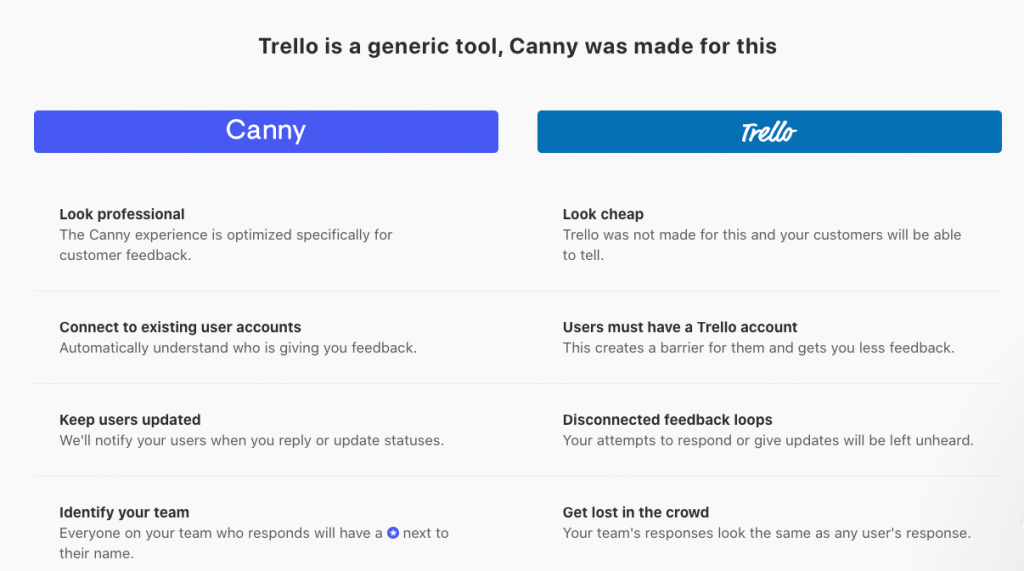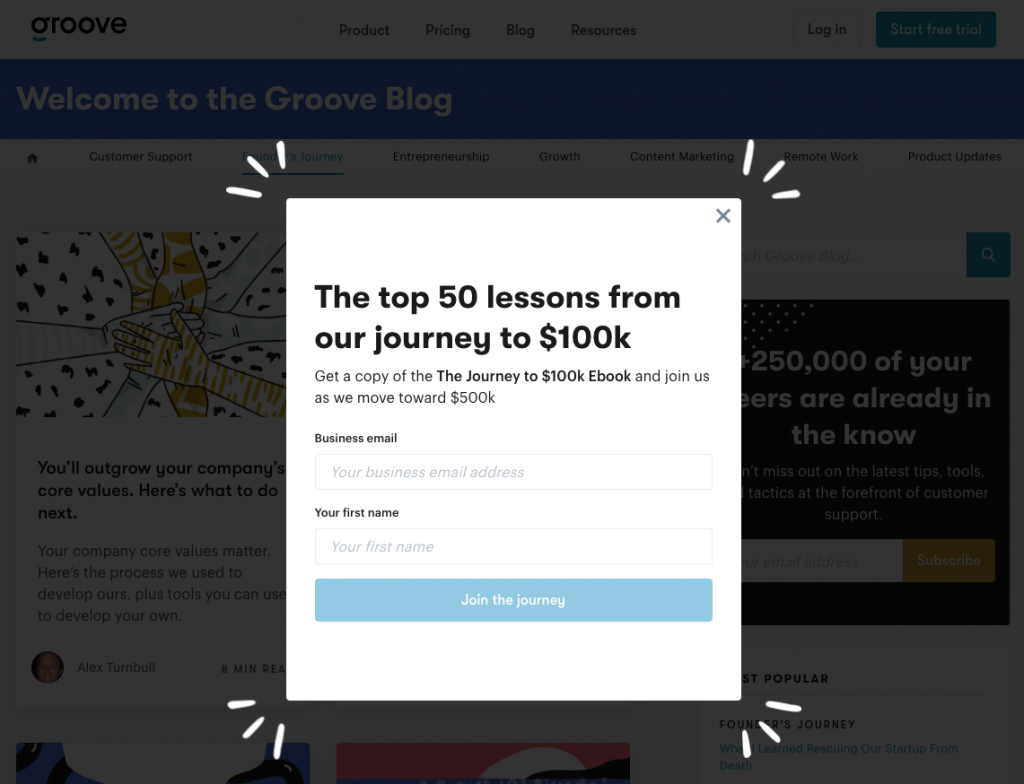Today, I’ll be sharing the story of Canny.io, a three years old bootstrapped SaaS startup that is already doing $800k ARR with a seven-member team. A lot of its success is due to the content marketing strategies used by the founders in the early stages of the company.
For most new startups, content marketing starts with keyword research, writing blogs posts and publishing landing pages. But Canny took the road less travelled by. They decided to take a completely different approach to content marketing. And that’s what I want to highlight in this piece.
If you’re a content marketer or a founder of an early age startup, you’ll find Canny’s content strategies very interesting and useful. By reading the article you’ll get a sneak peek at how you can build a startup by just telling your story.
Table of Contents
1. Taking a practical approach to content marketing
Canny was started by Sarah and Andrew as a side project when they were both working at Facebook. When they saw Canny as an opportunity worth pursuing, they both quit their desk jobs to completely focus on Canny.
But they didn’t directly raise funds or start hiring. They took very calculated steps. Even after two years into the company and doing $400k ARR, they were only a five-member team.
 Canny’s ARR Growth YOY
Canny’s ARR Growth YOY
They knew two things –
1. They needed to focus on sharing the story of Canny first. It’s impossible to drive leads through a blog when people have no clue about your brand.
2. Focusing on the quality rather than quantity.
Hence, they didn’t hire freelancers or content marketers straightway to write about their product. Instead, they decided to share their journey through the blog. People loved their stories as they were sharing their personal journey. I mean how often do you see companies sharing their revenue.

Sarah Hum
Founder, Canny.io
To this day, Andrew and I mostly write about our journey and what we’re learning along the way. Back when we started, it wasn’t great for SEO, but it did start getting our name out there. We wrote what came most naturally to us (sharing our stories) and people resonated with that.
This helps us build a brand and show the actual people behind the company.
KEY TAKEAWAY
Before planning your content marketing strategy, it’s important to prioritise what you’re trying to achieve first. Do you want to drive leads? Increase brand awareness? You need to plan a content strategy according to your goals.
2. Storytelling is a Startup Founder’s Secret Weapon
People love stories. In fact, the history of storytelling goes back thousands of years. The ancient Greeks carved their language into walls to tell how history was moving forward.
We’ve all heard stories about companies like Amazon and Apple. For example, “Amazon was founded in the garage of Bezos’ rented home in Bellevue, Washington.” 
We’ve all seen this photo like hundred times
That’s not it, there are over 8 movies telling the story of Steve Jobs and Apple.
It’s clear that storytelling is a very important tool for founders. It helps them connect effectively with their team, customers, investors and more. Remember more than your product, people are interested in the story behind the company and its future vision.
Sarah and Andrew, the founders of the Canny.io have used this brilliantly. By sharing their stories on blogs under Founder Stories they’ve covered everything including how they got started, challenges, the vision behind the product and their accomplishments.
 Canny’s Blog
Canny’s Blog
They’ve written over 17 blogs under “Founder Stories” and about 13 blogs under “Building SaaS”. Most of these blogs are well received on social media. This was because they talked about subjects that we rarely see people talking about, like bootstrapping, turning down investors, being productive while working remotely, building startups as digital nomads and more.
Here’s a tweet from Sarah sharing a few metrics from 2019. It has over 116 comments, 240 retweets and 3.2k likes. Clearly people love to learn about different brands and how their accomplishments as well as failures.
1/ Today marks 3 years since I left my job @Facebook. In numbers:
— Sarah Hum (@sarahhum) November 18, 2019
💰 $650,000 ARR
👩🏻💻 1,464 commits
💬 34 investor chats turned down
✈️ 27 cities in 16 countries
💕 5-person team
🎉 3 team retreats
🚀 1 startup, @cannyHQ
✊ 0 dollars raised
In order to stay connected with their readers they nudge people to join their newsletter Canny Backstage (as shown below)
 Canny BackStage Popup
Canny BackStage Popup

Sarah Hum
Founder, Canny.io
Don’t discount the “brand building” content. While it’s hard to measure, you’ll gain supporters and word-of-mouth. This kind of content is also much easier to write if you’re telling a story.
3. Getting interviewed on podcasts and blogs
People love listening to podcasts. According to a report over 51% of all US population has listened to podcasts and the number is only growing. More and more brands are using podcasts to share their story to the world.
Canny’s founders have been on many podcasts and interviews. Some big names including the MongoDB, IndieHackers and TheEffective Founder. This has helped them to share their story at almost zero cost. This has been only possible because of the learnings they consistently share on their blog.
 The Indie Hackers Podcast
The Indie Hackers Podcast
Apart from this, Sarah actively contributes to other blogs too. Recently she wrote a post on Baremetrics to share how they bootstrapped to $800k. Apart from they’ve been featured by CharMogul, StartupGrind and other publications. She’s also been a speaker at the UpperCase conference by MissingLettr.
 MissingLettr Conference
MissingLettr Conference
Overall their strategy has helped them get both external visibility and organic links. This wouldn’t have been possible otherwise.
4. Crafting customer stories that boost conversions
Case studies are a quite common content type for B2B companies. They form an important piece of the content strategy. It’s a great way to show off the value of your product.
But Canny.io takes it the next level. Here’s what stood out –
1. Showing real faces – Be it the homepage or the case study page, there are pictures of their customers. This helps users to connect with their brand. More than the logo it’s important to show the the faces of your customer.

I love the case study page layout. It really nudges you to read further.

Also, love how they’ve highlighted Tim Soulo’s testimonial. But does it any clicks at all? It is clickable though. Leave your opinion in the comments section.
2. Showing off numbers – With every case study, Canny.io shares the how old the customer is and the number of total upvotes (for feature requests) they’ve got using Canny. This is a nice addition as it shows off the real value of their tool.

In the results section, they even got a little deeper by showing how many users have given feedback using their platform.

3. Actionable – The case studies is packed with numbers, screenshots and focuses on showing how the customer is using their product. You’ll also see a lot of quotes which adds credibility to the case study.
It’s clear that they didn’t focus on getting more case studies rather but show just their power users. This is undoubtedly a better strategy if you lack resources.
5. Getting the basics right
While Canny’s content marketing strategies might not the match Hubspot or G2Crowd, for a two member team it’s quite impressive. The major reason behind it is that they got the basics right.
1. Scaling their blog at the right time
While for a long time Canny.io focused on sharing their journey, they recently hired a full-time content marketer to take it to the next level.
Since many people know them now, they’re focusing on writing articles around their product and their niche. They’ve over 60+ article on their blog. They even accept guest posts now.

Bri Morgaine
Content Marketer, Canny.io
When working as a content marketer for a small startup, I’d say the biggest difference is around bandwidth; larger SaaS companies have larger content + marketing teams overall, as well as potentially more folks to create guest content, available for partnerships, etc.
The strategy doesn’t differ as much as the capacity differs; at a small startup, you have to be very selective in terms of what marketing activities deserve your focus and time.
2. Getting everyone to contribute
Working on blogs shouldn’t be the responsibility of the marketing team, especially when you’re a small team. Everyone’s free to share their thoughts. Actually people love to learn different perspectives.
Canny.io has nailed this. Right from the founders to the customer success folks have contributed to the blog. This has been immensely helpful in pushing regular content as a lean team.

Bri Morgaine
Content Marketer, Canny.io
Ask your team to write what they know. There’s always something of value that they can share based on personal experience—whether that’s project management, founder stories, lessons learned from failure, etc.
Also, outlining helps. Handing someone a topic with a few bullet points of info you’d like them to cover can make the prospect of writing less intimidating for someone on your team who “isn’t a writer.” Asking them to write out answers to a couple questions and then fleshing out an article around their responses works well too.
3. Capturing leads
While Canny don’t overwhelm their readers with blog subscription popups they do nudge people to signup for their blog. I personally love their Canny Backstage popup.

The popup is really stands out. I’m confident this converts better than all other popups.
4. Competitor Landing page
When you’re new in the market, it’s important to show off the real advantage of your tool. This is something which will persuade users to even consider you.
Interestingly, one of Canny’s biggest competitors is Trello. Even though it isn’t built for collecting customer feedback, you must have seen a lot of companies using to track feedback. But Canny tackles this by saying “Trello is a generic tool, Canny was made for this”.

That’s brilliant copywriting. They’ve used the similar approach for their other competitors.
6. What can we learn from Canny?
There’s a lot to learn from Canny. It’s a perfect example of a profitable bootstrapped lean SaaS company. Well, obviously they didn’t reach here just by sharing their story. It’s important to build a great product and find your target users.
But I’d like to highlight a few points which we can implement in our own businesses-
Focusing on brand building content – Companies easily miss out on this. I mean how many times do you see such type of content on a company’s blog? But it’s actually very useful. Canny’s a great example. In fact, GrooveHQ also found a lot of success by sharing their journey on their blog.

Play to your strengths – Don’t aim to do a hundred things. Just focus on the tactics that gets you the most results. That’s what will help you move the needle.
Being transparent – People love transparency. It can actually help you stand out. One of the main reasons why people know Canny is because of the fact that the founders never hesitated in sharing different metrics. However not everyone might be open in sharing sensitive information such as revenue. But you can always skip them.
Hiring sustainably – Sarah says “We don’t spend money we don’t have. That meant that we didn’t hire until we knew the business was in a good place.”
So be it marketing or any function, hire only when you think it’s the right time and most importantly when you know you have the money to do it. You don’t need a hundred people to build a company, you just need a group of self-motivated people who align with your vision
Related Growth Stories



